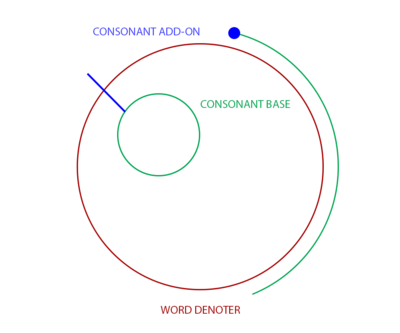Circular Gallifreyan
Introduction
Gallifreyan is the language spoken by the Time Lords of Gallifrey from the British TV show Doctor Who.
The Time Lords are a time-aware species capable of traveling through time and space who have taken upon themselves to protect the Web of Time from other time traveling species.
This is a fan created language made for the fans without any intention to be legally bound or profiting from it.
Phonology
Consonants
| Bilabial | Labio-Dental | Dental | Alveolar | Post-Alveolar | Retroflex | Palatal | Labio-Velar | Velar | Uvular | Pharyngeal | Glottal | |
|---|---|---|---|---|---|---|---|---|---|---|---|---|
| Nasal | m | n | ɳ | ɲ | ||||||||
| Plosive | p / b | t / d | ʈ | ɟ | k / g | ʔ1 | ||||||
| Fricative | ɸ | v | θ | s / z | ʃ | ç | χ | ħ2 | ɦ | |||
| Affricate | t͡s | t͡ʃ / d͡ʒ | ʈʂ | q͡χ | ||||||||
| Lateral approximant | l | ʎ | ||||||||||
| Approximant | ɹ | j | w | ɰ | ||||||||
| Thrill | ʙ3 | r | ||||||||||
| Implosive | ɠ |
| Blends: | qy |
- a) Only between or before vowels. b) For cases markers.
- Only between or before consonants
- Used when b is before any vowel at the beginning of a word, allophone of /b/
Vowels
| Front | Near-Front | Central | Back | |
|---|---|---|---|---|
| Close | i | u | ||
| Near-Close | ʏ | |||
| Close-mid | e / ẽ | ɘ | o | |
| Open-mid | œ | |||
| Open | a / ã | ɑ / ɒ |
Epenthesis
Elision
Consonant Mutation
Devoicing
Aspirate Mutation
Prosthesis
Modern Gallifreyan has two forms of prosthesis:
r-
[r] is added if a word begins with a vowel after the 3rd singular and all plural possessives. Also for concepts about time after the preposition "in".
u-
The vowel [u] is added before words beginning with voiced fricatives [s] and [ʃ] when followed by another consonant.
skegletorah (language) — [uskegletorah]
Orthography
Circular Gallifreyan is mostly written in a series of interlocking circles. Each word is composed of other circles and a sentence is encapsulated by a yet bigger circle. A word is written inside a word denoter and each word goes inside a sentence paradigm, which will be explained later on.
Consonants
They are classified by consonant bases and then sub-divided by consonant add-ons.
On the following table we have to the right the bases and on the top the add-ons. The straight line under the base symbols represents the word denoter and its relation with the bases:
| m | b | t | d | p | ʈ | ||||
| n | ɳ | ɲ | |||||||
| k | χ | w | g | ɰ | ɦ | ɠ | |||
| r | q͡χ | ɹ | ħ | rː͡χ | ʙ | ||||
| ʃ | t͡ʃ | ʈʂ | |||||||
| s | z | θ | l | t͡s | |||||
| v | ɸ | ||||||||
| d͡ʒ | qy | ç | ʎ | j | ɟ | ||||
| ʔ |
Vowels
They are as well classified by a base called dot bases and these divided by directional lines. Each vowel is written along the consonant that comes before. If the word starts with a vowel or there are no consonants before the vowel is placed on the word denoter instead. On the table, the right column represents the dot bases and the top arrows the directional lines. The semi-circles on the right symbolize the consonant bases.









